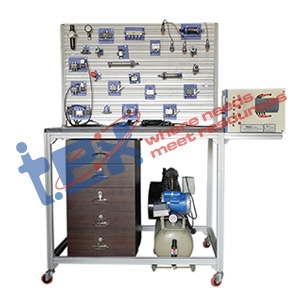

The PLC Based Pneumatic Trainer is a modern automation training system designed to teach the integration of Programmable Logic Controllers (PLC) with pneumatic control systems. This educational setup allows students to understand how pneumatic actuators, sensors, and valves operate under PLC-controlled logic for automation applications.
The trainer is ideal for Engineering Colleges, ITIs, Polytechnics, and Technical Training Centers, helping learners gain hands-on experience in process control, industrial automation, and mechatronics. It bridges theoretical knowledge and industrial practice, preparing students for real-world automation systems.
This PLC Based Pneumatic Trainer consists of a PLC control panel, solenoid-operated directional valves, pneumatic actuators (cylinders), sensors, air supply unit, and connecting pipelines. The system enables students to design, simulate, and execute various pneumatic circuits such as sequential operation, clamping, and timing control using PLC logic.
The PLC communicates with the pneumatic components through digital input/output modules, allowing learners to program ladder logic, sequence control, and interlocking functions. The educational setup demonstrates the working of automation in processes where compressed air is used for actuation.
All components are mounted on a powder-coated metal frame for durability, safety, and easy accessibility. The trainer provides a strong foundation in electro-pneumatic and PLC integration, essential for modern industrial systems.
| Specification | Details |
|---|---|
| Power Supply | 230V AC, 50Hz |
| PLC System | With digital I/O modules and ladder logic software |
| Pneumatic Components | Cylinders, valves, air filter, and pressure regulator |
| Valves | Solenoid-operated directional control valves |
| Sensors | Proximity / limit switches for feedback |
| Working Medium | Compressed air (2–8 bar) |
| Programming Interface | PC or HMI-based control interface |
| Construction | MS powder-coated frame with labeled fittings |
| Safety Features | Overload, pressure relief, and emergency cut-off |
| Optional Add-ons | SCADA or HMI integration for monitoring |
The PLC Based Pneumatic Trainer gives students complete exposure to industrial automation concepts, integrating electrical control through PLCs with pneumatic actuation. It enhances analytical skills and prepares learners for real-time process control environments.
Students can design, simulate, and test pneumatic circuits, study actuator responses, and understand interlocking logic used in modern automation systems.
This unit is a valuable educational tool for Engineering Colleges, ITIs, and Technical Institutes, providing hands-on experience in automation technology, control systems, and mechatronic applications.